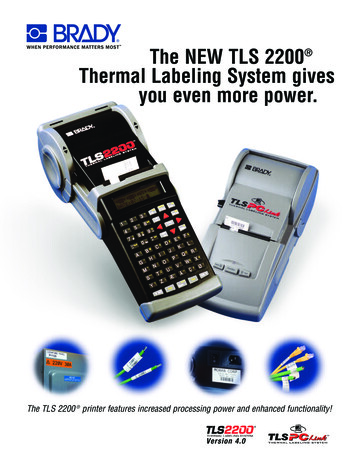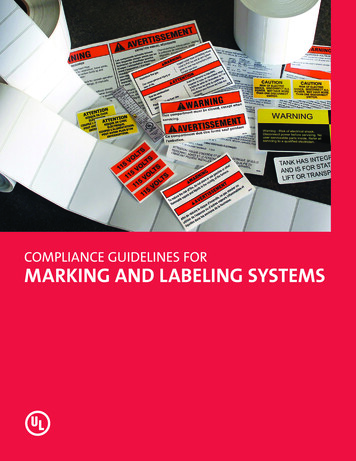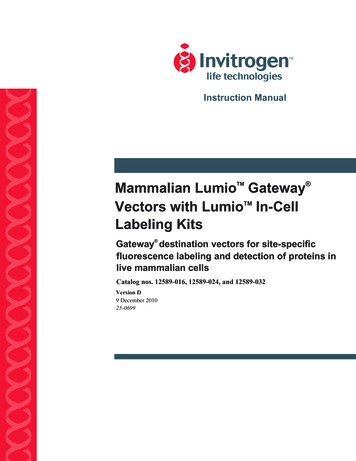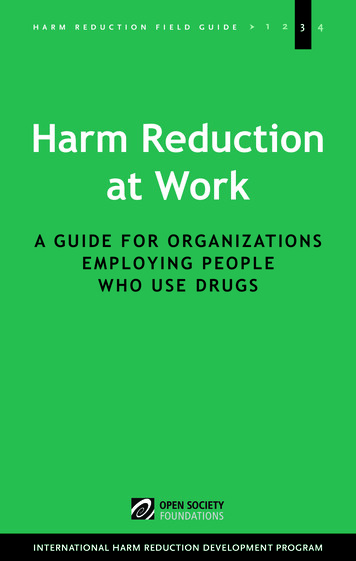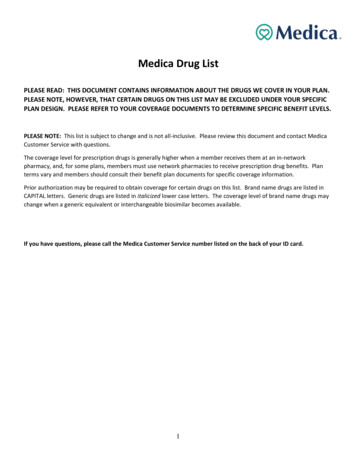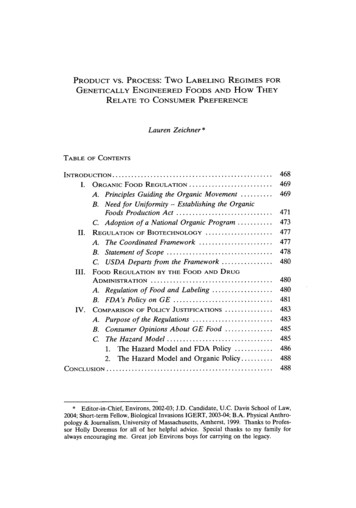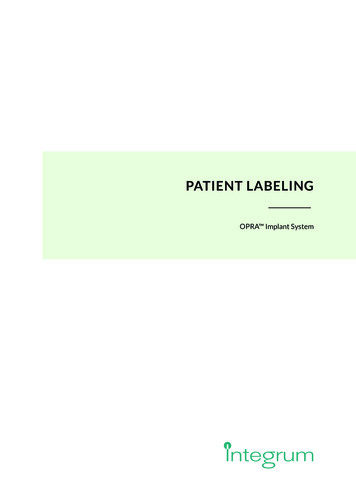
Transcription
PATIENT LABELINGOPRA Implant System
PATIENT LABELINGTABLE OF CONTENTSGLOSSARY3CAUTION4DESCRIPTIVE INFORMATION4PURPOSE OF THE DEVICEDESCRIPTION OF THE DEVICESCONTRAINDICATIONS8RISK/POTENTIAL BENEFIT INFORMATION8POTENTIAL BENEFITSRISKSINDICATIONSGENERAL WARNINGS AND PRECAUTIONSMRI SAFETY INFORMATIONWARNINGSPRECAUTIONSIMPORTANCE OF FOLLOWING A CARE REGIMENOPERATING INFORMATIONPREOPERATIVE ASSESSMENTSSURGERY PROCEDUREPOST-OPERATIVE MANAGEMENT AFTER STAGE 1 SURGERYMOBILIZATION AFTER STAGE 1 SURGERYPOST-OPERATIVE MANAGEMENT AFTER STAGE 2 SURGERYFOLLOW-UP PROGRAM AFTER STAGE 2 SURGERYCHECK-UP SCHEDULEREHABILITATION AFTER STAGE 2 SURGERYTRAINING PROGRAM8910101011121213131313131314141414FOLLOW-UP OF MECHANICAL FUNCTION16WHEN TO CONTACT YOUR DOCTOR16HYGIENE RECOMMENDATIONS17INSTRUCTIONS FOR CLEANING THE AREAWHERE THE ABUTMENT DEVICE EXTENDS OUT OF THE SKININ CASE OF IRRITATION OR INFECTION2441717CLINICAL RESULTSORIGINAL 51-PATIENT OPRA STUDYADDITIONAL ANALYSIS WITH 65 PATIENTS181820TRAVEL20EXPECTED SERVICE LIFE21CONTACT INFORMATION21APPENDIX 1: OPRA AXOR II REPORT FORM22WHEN TO CONTACT YOUR DOCTOR23
PATIENT LABELINGHYGIENE RECOMMENDATIONSINSTRUCTIONS FOR CLEANING THE AREAWHERE THE ABUTMENT DEVICE EXTENDS OUT OF THE SKININ CASE OF IRRITATION OR INFECTION242424GLOSSARYOPRA - Osseoanchored Prostheses for the Rehabilitation of AmputeesABUTMENT - a skin-penetrating device connected to the Fixture for connection to the external prosthesisAMBULATION - walkingARTIFICIAL LEG; FOOT - part to replace a missing leg or footBISPHOSPHONATES - drugs to reduce bone lossCOMPUTED TOMOGRAPHY - radiographic method that provides cross sectional (slices) images of the body. Alsoknown as CT or CAT scanning.DRAINING - fluid coming from wound after surgeryDRESSING - wound bandageFIXTURE - the device that is implanted into the thigh boneMECHANICAL FUNCTION – how the working parts operateNEUROPATHY OR NEUROPATHIC DISEASE - abnormal sensations and pain due to nerve damageNSAIDs – Non-Steroidal Anti-Inflammatory Drugs – drugs such as ibuprofen and aspirin that reduce pain andinflammationRELEASE FUNCTION – The Axor II releases when subjected to high bending and/ or rotational moments in order toprotect the OPRA Implant System from excessive loadsOSSEO-ANCHORED - bone growth to an implantOVERLOAD – too much force on the OPRA Implant System which can be caused by climbing, jumping, kicking, carrying heavy items or other activities.PHANTOM PAIN - sensation related to a limb that is no longer part of the bodyPHYSICAL THERAPIST – person who helps patients walk again, have less pain and be more active.PROSTHESIS – artificial leg and footPROSTHETIST – a prosthesis specialist; a person who designs, fits or services a prosthesisRELEASE LEVEL – the load that causes the Axor II to release in bend or rotation by twisting the artificial footAXOR II - a prosthetic safety device connected to the AbutmentSOCKET PROSTHESIS - a removable artificial leg and foot attached to the stump by a socket.TRANSFEMORAL AMPUTATION - amputation of the leg above the knee3
PATIENT LABELINGCAUTIONThe OPRA Implant System may be used only in conjunction with the associated or recommended components andaccording to the instructions for use. Integrum AB does not authorize, or accept responsibility for, any use of the OPRA Implant System in any manner inconsistent with this Patient labeling.DESCRIPTIVE INFORMATIONPURPOSE OF THE DEVICEThe OPRA Implant System is intended for use in patients with above knee amputations due to trauma or cancer andwho have or are anticipated to have rehabilitation problems with or cannot use a conventional (regular) artificial legprosthesis.The OPRA Axor II device is designed to protect the OPRA Implant System from damage caused by overloads. TheAxor II connects the Abutment and the prosthesis. In the event of excessive twisting or bending of the prosthesis, theAxor II releases the prosthesis to prevent damage to the bone anchored Fixture. The Axor II is intended for daily use.However, you will need to complete the training program before you will be able to use your prosthesis for long periodsof time. You should discuss your daily activities with your physician to make sure that they can be performed safely withthis device.You may be a candidate for the OPRA Implant System if you have had a transfemoral (above the knee) amputationdue to trauma (injury) or cancer and have or are anticipated to have difficulty wearing your socket prosthesis (artificialleg), high levels of pain when wearing your artificial leg prosthesis, or skin problems resulting from wearing your socketprosthesis.CAUTION: Federal (USA) law restricts this device to sale by or on the order of a physician.DESCRIPTION OF THE DEVICESOPRA IMPLANT SYSTEMThe OPRA Implant System is composed of parts that allow a prosthesis to attach directly to the femur (thigh bone). Thesystem is designed so that any moderate overload or complication will result in the release of the prosthesis to preventdamage to the surgically implanted parts of the OPRA Implant System.The OPRA Implant System consists of seven components that are implanted during two surgeries:1. Fixture - a titanium screw that will anchor the artificial leg prosthesis to the femur.2. Central Screw - a screw made of titanium that allows access to the bone without removing the Fixture.3. Healing Cylinder - a part made of titanium that prevents bone from growing into the Fixture opening wherethe Abutment will be placed during the second surgery. The Healing Cylinder is implanted during the first surgeryand removed during the second surgery.4. Healing Washer – a metal washer made of titanium that gives support to the bone graft. It is implanted duringthe first surgery and removed during the second surgery.5. Graft Screw – a titanium screw inserted into the Healing Cylinder that holds the bone graft in place.It is implanted during the first surgery and removed during the second surgery.6. Abutment - a titanium part that attaches to the Fixture and extends outside the skin to allow the attachmentof the prosthesis. It is implanted during the second surgery.4
PATIENT LABELING7. Abutment Screw – a screw made of titanium alloy that locks the Abutment to the Fixture. It is implanted duringthe second surgery. Any retightening of this screw should only be performed by your physician or prosthetist.The individual parts of the OPRA Implant System are shown in Figures 1 and 2.FIRST SURGERYIn the first surgery (Stage 1), the Fixture is implanted in the femur (thigh bone) and the Central Screw is inserted into theFixture. Next, the Healing Cylinder is attached to the Fixture. Then a bone graft (extra bone already removed from yourthigh or bone from your hip bone) is placed and a Graft Screw is inserted in the Healing Cylinder to hold the bone graftin place. If needed, a Washer can be used to keep the bone graft in place. The healing period for this surgery is about6 months. During this period, the bone grows onto the Fixture to anchor it in the femur. This bone growth process iscalled osseo-anchoring. The Healing Cylinder prevents bone from growing into the opening in the Fixture where theAbutment will be attached during the second surgery.WasherFixtureCentral ScrewHealing CylinderGraft ScrewFigure 1: OPRA Implant System Parts Implanted in First Surgery.SECOND SURGERYAfter the healing period is complete, the patient is ready for the second surgery (Stage 2). In this surgery, the HealingCylinder, Washer and Graft Screw are removed, and the Abutment is attached to the Fixture. Part of the Abutmentextends outside the skin to allow the prosthesis to be attached. An Abutment Screw is then attached to lock the Fixtureand the Abutment together.The OPRA Implant System parts are shown in Figure 2 below. For more information on surgeries, please see the sectionSurgery Procedure.FixtureAbutmentAbutment ScrewSkinBoneFigure 2. Illustration of the Fixture and Abutment parts of the OPRA Implant System placed in the femur bone ofthe amputation stump.5
PATIENT LABELINGOPRA AXOR The OPRA Axor II attaches to the Abutment end that is outside of the skin and acts as a safety connection betweenthe Abutment and the prosthesis. It is designed to prevent damage to the bone-anchored Fixture if it is overloaded. If anoverload occurs, the Axor II twists the prosthesis to protect the Fixture from damage. The OPRA Axor II must beinstalled and serviced by a prosthetist (person who specializes in prostheses).The Axor II releases when subjected to high bending and/or rotational moments in order to protect the OPRA ImplantSystem from excessive loads.Release modes:[[ In the bending/flexion direction the Axor II is opened according to Figure 3.[[ In the rotational direction the Axor II rotates around its axis in both clockwise and counterclockwise directionsaccording to Figure 4.The two release mechanisms are the normal and fundamental functions of the Axor II and can be reset by the patientwithout using any tools. The Axor II has been tested to pass numerous release/reset procedures without any changeof the settings.Figure 3. Bend release.Figure 4. Rotation release.Your prosthetist (prosthesis specialist) has adjusted the release level setting for the OPRA Axor II to suit you. Youshould NEVER change the settings yourself.If the release level is exceeded, the OPRA Axor II will release in bend or rotation by twisting the foot or releasing thefoot. You can avoid overloading the OPRA Axor II by following and completing the training plan and discussing yourpost-operative activities with your physician.If OPRA Axor II has released by twisting your foot or stumbling, you may reset it to yourself. Your prosthetist (prosthesis specialist) will show you the proper procedure. It is important to reset the prosthetic foot back to its exact originalposition. After you reset the OPRA Axor II, you should not continue performing the same activity that caused thedevice to release.After your OPRA Axor II released in bend and/ or rotation your prosthetist (prosthesis specialist) will give you aOPRA Axor II Report Form to use to if the product do not function as intended. A copy of the OPRA Axor II ReportForm is provided in Appendix 1.The OPRA Axor II should be removed before laying down on a couch, bed or other flat surface.The OPRA Implant System, the OPRA Axor II and the prosthesis are shown in Figure 5. The OPRA Implant System,the OPRA Axor II and the prosthesis are shown on a person in Figure 6.6
PATIENT LABELINGFigure 5: Illustration of the OPRA ImplantSystem, Axor II and the prosthesis.Figure 6: The OPRA Implant System,OPRA Axor II Device and artificial leg and foot7
PATIENT LABELINGCONTRAINDICATIONSThe OPRA Implant System is not recommended for patients if any of the following is applicable: The patient’s bone growth is not complete based on X-ray examination. The patient has bone anatomy that is not typical and may affect treatment with OPRA .Examples of bone anatomy that is not typical:o Bone measurements outside defined interval.o Unexpected developmento Conditions which are not favorable for device to be installed such as deformities, fracture, infection. The patient would have less than 2 mm of remaining cortex bone available around the implant, if implanted. The patient has osteoporosis (weak bones). The patient is older than 65 years or younger than 22 years. The patient’s body weight is higher than 220 lbs including the prosthesis. The patient suffers from other diseases that might affect treatment with OPRA . Examples of other diseases are:o Severe peripheral vascular (blood vessels outside the brain and heart) disease.o Diabetic mellitus (diabetes) with complications.o Skin disorders involving the stump.o Neuropathy or neuropathic disease (damage or disease to nerves) and severe phantom pain.o Active infection or dormant (currently not active) bacteria.o Metabolic bone disease and/or metastatic lesions in the residual femur. The patient is pregnant. The patient is not expected to be able to follow the treatment and follow up rules.RISK/POTENTIAL BENEFIT INFORMATIONPOTENTIAL BENEFITSHaving the prosthesis directly anchored into the bone reduces the problems of leg prosthesis attachment and improvesthe function of the prosthesis. This is shown by results from amputees already treated with the OPRA Implant System.However, this attachment can never totally make up for or replace the lost leg.Patients with the bone-anchored prosthesis report improved mobility, quality of life, perception of where and how theirsteps are placed, increased ability to perform daily activities, and a decreased feeling of being disabled. Using the OPRA Implant System also lessens the risk of (mitigates) skin irritation problems that are common for prosthesis users.8
PATIENT LABELINGThe OPRA study has shown the following benefits:[[ an improved range of movement around the hip joint, not stopped by a socket brim;[[ increased prosthetic use, level of function and mobility, including longer walking distances and increasedsitting comfort;[[ improved quality of life; and[[ reduced socket related soft tissue problems.RISKSAs in all surgical procedures, the OPRA treatment is associated with certain risks, which might lead to poor results.Improper use such as failure to follow and complete the required training, excessive physical activity that overloads thedevice, or injuries such as falls will increase the risks.The following risks were associated with the OPRA Implant System in a 2-year clinical study of 51 patients:[[ Superficial (skin) infection: 28 (55%) subjects had this effect[[ Deep infection: 3 (6%) subjects had this effect[[ Loosening of the Fixture: 4 (8%) subjects had this effect[[ Pain: 6 (12%) subjects had this effect[[ Injury: 4 (8%) subjects had this effect[[ Mechanical complication of the Abutment and/or Abutment Screw: 4 (8%) subjects had this effect[[ Myositis (inflamed muscle): 1 (2% ) subjects had this effect[[ Soft tissue necrosis (soft tissue death): 2 (4% ) subjects had this effect[[ Blister: 1 (2%) subject had this effect[[ Skin necrosis (dead skin): 3 (6%) subjects had this effect[[ Chills: 1 (2%) subject had this effect[[ Impaired (poor) healing: 1 (2%) subject had this effect[[ Fever: 2 (4 out of 100) subjects had this effect[[ Wound necrosis (death of tissues): 1 (2%) subject had this effec[[ Fracture: 3 (6%) subjects had this effect[[ Joint injury: 1 (2%) subject had this effect[[ Post surgical bruise: 1 (2%) subject had this effectSimilar events have been observed to 5-years post-surgery.If any of these complications occur, they must be treated promptly by your physician. Infections can be serious and shouldbe treated. Patients with infections must be monitored regularly since there is a risk that treated infections will becomeactive again. Deep infection can require long-term antibiotic treatment (up to 6 months) or removal of the implant. In thestudy, 4 subjects had deep infection, and in one subject the implant was removed. Complications such as loosening of animplant or bone infection, may occur over the long-term use of the system, so your physician should be contacted immediately if you notice any of the conditions referenced in Section, When to Contact Your Doctor, on page 16.The components of the OPRA Implant System are designed to be replaceable if they wear or break. Long-term successof the OPRA system has not yet been established, so there is a risk that all of the components of the implant systemwould have to be removed and that the stump would need to be shortened an additional 4 inches.9
PATIENT LABELINGINDICATIONS[[ The OPRA Implant System is indicated for patients who have transfemoral amputation due to trauma or cancerand who have or are anticipated to have rehabilitation problems with, or cannot use, a conventional socketprosthesis. The OPRA Implant System is intended for skeletally mature patients.[[ The patient failed to receive benefit from socket prostheses or is expected to not tolerate socket use due toproblems such as:o Recurrent (repeated) skin infections and ulcerations (skin sores) in the socket contact areao Paino A short stump preventing the use of socket prosthesiso Volume fluctuation (size change) in the stumpo Soft tissue scarringo Extensive (large) area of skin graftingo Socket retention problems (problems keeping the socket in place) due to excessive perspiration (sweating)o Restricted mobility (cannot move fully)OTHER WAYS TO REDUCE PROSTHETIC PROBLEMSThere are other methods to reduce prosthetic problems. One method is one or more plastic surgery operations to adjustthe shape of the amputated limb. Another method is to avoid using a prosthesis. For each person, the best solution shouldbe considered and evaluated.GENERAL WARNINGS AND PRECAUTIONSMRI SAFETY INFORMATIONNon-clinical testing has demonstrated that the OPRA Implant System is MR Conditional. A patient with this device canbe safely scanned in an MR system meeting the following conditions:[[ Static Magnetic field of 1.5 and 3.0 T[[ Maximum spatial field gradient of 4500 gauss/cm (45 T/m)[[ Maximum MR system reported, whole body averaged specific absorption rate (SAR) of 2 W/kg (normal operationmode) when the implant is at least 20 cm out of isocenter.RF heating tests of the OPRA Implant System showed high expected temperature increase for a wbSAR of 2W/kg after15 minutes of continuous scanning when at the isocenter. Moving the device 20 cm out of iso center, as listed in the conditions above, reduced heating to 3.9 C.In non-clinical testing, the image artifact caused by the device extends approximately up to 45 mm from the OPRA Implant System when imaged with a gradient echo pulse sequence and a 3.0 T MRI system. It is likely that clinical MRprotocols may show smaller artifacts.10
PATIENT LABELINGWARNINGS[[ Smoking negatively impacts bone growth onto the Fixture device.[[ Healing problems can occur in obese patients.[[ After you are implanted with the OPRA Implant System, if you have non-emergency surgery for any reason,you should notify your physician of your implant and consider taking antibiotics to reduce the risk of infection. Donot self-administer antibiotics[[ Patients with both unilateral (one leg) and bilateral (two leg) amputations have been treated withthe OPRA Implant System. As only a small number of bilateral patients have been treated, results in bilateralpatients are unknown and definite conclusions cannot be made from study results.[[ If you have a history of previous infection on the amputated side, you should be carefully evaluated with bloodwork to determine that you do not have an on-going infection. Also, bone cultures (examination of bone marrow)should be done to make sure that no inactive infection is present.[[ Joint problems that might make it difficult to walk, such as arthritis in your hip or other leg, may negativelyaffect this treatment.[[ The following drugs may negatively affect bone growth onto the Fixture and cause loosening of the Fixture:o Oral or injected steroids; ando Chemotherapy drugs.[[ You will typically not be a suitable candidate for treatment with the OPRA Implant System if:o You are using the prosthesis every day more than 13 hours; oro You do not report more than moderate trouble and moderate reduction of quality of life.In these instances, alternative treatments, such as socket modifications (changes), general amputeerehabilitation (physical therapy), or soft tissue or bone surgery might better address your rehabilitation problems.[[ The following drugs should not be used during the first year of treatment:o NSAID (Non Steroid Anti Inflammatory Drugs) such as ibuprofen and aspirin two weeks before surgery or forcontinued use after surgery; ando Bisphosphonates (drugs to reduce bone loss).[[ Contact your treating physician immediately if you have pain from your leg and increased body temperature(fever).11
PATIENT LABELINGPRECAUTIONS[[ For at least 6 months after Stage 1 (S1) surgery, you must not put your full weight on the prosthesis. Putting fullweight on the prosthesis is normally allowed about 6 months after the Stage 2 (second) surgery, following acheck-up by the treatment physician.[[ Standing and walking must be done according to individualized training programs.[[ The OPRA Implant System is intended for use with normal physical activity.[[ If your bone quality is not the best, full weight bearing on the prosthesis should begin more gradually and ata reduced pace as determined by your physician.[[ If your OPRA Axor II is damaged in any way, contact your prosthetist (prosthesis specialist).[[ If your OPRA Axor II has been immersed in water, contact your prosthetist (prosthesis specialist).[[ You should take special care of your OPRA Implant System:o Never try to fix any problems with the OPRA Implant System yourself. Never use any tools on the OPRA Implant System as you might damage the Abutment, Abutment Screw and the Fixtureo If the OPRA Implant System is overloaded, the Fixture could be severely damaged.! Never run, jump or climb.! Always use a cane or crutches for longer walks.! Never lift or carry heavy items.! Never subject the OPRA Implant System to high torque (twisting motions).o Always check carefully that the prosthesis is adequately attached to the Abutment.o While riding a bike, your knee joint might lock in the fully stretched position. This can seriously damage theFixture. Always position the bike seat low enough that your knee cannot fully stretch out while cycling. Neverstand up while you are cycling.o Retightening of the Abutment Screw shall only be performed by professionals. If the retightening isperformed in an uncontrolled way (not performed by a professional according to protocol) there a risk formechanical complications with the Abutment and Abutment Screw.o If the Abutment or Abutment Screw is replaced, the screw must be retightened by your treating physician.Additional appointments may be necessary to ensure that the system is working correctly.o Always be careful when you are in hot or cold places.! In the sauna, wrap a wet towel around the Abutment to protect it from heat.! Protect the amputated limb when in a cold environment.o Always avoid damaging yourself or others with the Abutment.! Protecting the Abutment during sleep is recommended. The protection will be provided by your prosthetist(prosthesis specialist).IMPORTANCE OF FOLLOWING A CARE REGIMENFor the OPRA Implant System to perform as intended, it is critical that you understand the warnings and precautions(as outlined in the section above) and follow the directions of your surgeon, prosthetist (prosthesis specialist), and physical therapist (person who helps patients walk again). In addition, it is important that you go to all follow-up appointmentsas the OPRA Implant System requires on-going monitoring in the15-20 years after implantation. It is also importantto observe good hygiene (cleanliness) to minimize the risk of infection. For additional information, please see Section,Hygiene Recommendations on page 17.12
PATIENT LABELINGOPERATING INFORMATIONPREOPERATIVE ASSESSMENTSA team of an orthopedic surgeon, physical therapist (person who helps patients walk again) and prosthetist (prosthesisspecialist) will determine if you are a candidate for the OPRA Implant System. The decision is based on clinical examination, radiographic examination, and your amputation status.The radiographic evaluation includes x-rays to determine bone quality, make measurements and look for any abnormalities, as well as CT scans to determine the correct Fixture length and to verify thigh bone length.If you have a medical history of previous infection on the amputated side, laboratory analysis will be done at specifictimes as defined by your surgeon to make sure that you do not have an ongoing infection.If you are a candidate for the OPRA Implant System, your kidney and liver function will be tested to see if you are able tosafely take oral or intravenous (given into a vein) antibiotics. If you receive the OPRA Implant System, you will be givenantibiotics starting on the day of each surgery until 2 days after your sutures are removed. The purpose of the antibioticsis to reduce your risk of infection. Additionally, if you have an infection after surgery or later during the long-term use ofthis device, you may be given antibiotics.SURGERY PROCEDUREThe treatment consists of two surgeries. The surgeries are performed under anesthesia. After each surgery you willspend 5-7 days in the hospital.STAGE 1During the first surgery (Stage 1, S1), a screw-like anchor (Fixture) is inserted in the inner canal of the thigh bone. Aftersurgery, the Fixture is not used for at least 6 months to improve bone healing. During this period, some patients mightbe able to use their socket prostheses.STAGE 2During the second surgery (Stage 2, S2), the Abutment is attached to the end of the Fixture. The Abutment goes throughthe skin and makes it possible to attach the prosthesis to the OPRA Implant System. Approximately 4-6 weeks after thesurgery, mobilization (movement) is carried out under the supervision of a physical therapist (person who helps patientswalk again). Full weight bearing with a leg prosthesis is normally allowed approximately 6 months after Stage 2 (see Section, Precautions on pages 12).POST-OPERATIVE MANAGEMENT AFTER STAGE 1 SURGERYAfter the S1 surgery, your sutures (stitches) will be removed after about 3 weeks, and after 6 weeks, you will normally beallowed to use a socket prosthesis and return to your pre-surgery activities. Your socket prosthesis should be adjustedby a prosthetist (prosthesis expert) so that the socket does not touch the end of the bone in your stump; otherwise,healing may be reduced or delayed.MOBILIZATION AFTER STAGE 1 SURGERYJoint movement, strength and fitness training instruction will be provided to you and supervised by your physical therapist (person who helps patients walk again). When the skin is healed enough, patients who used prosthesis before theOPRA treatment can begin using an adapted prosthesis 1-3 weeks after suture removal.POST-OPERATIVE MANAGEMENT AFTER STAGE 2 SURGERYAfter the S2 surgery, the bandage applied to the wound should be changed 2 times per week until the skin has healed.Your treating physician will prescribe antibiotics to reduce your risk of infection. Approximately 3 weeks after the surgery, your physician will remove your sutures (stitches).13
PATIENT LABELINGFOLLOW-UP PROGRAMAFTER STAGE 2 SURGERYAfter surgery, your will return to your treating physician for follow-up exams that will include clinical, mechanical andX-ray evaluations.CHECK-UP SCHEDULEYou should follow up with your treating physician at the times following surgery shown in Table 1.Table 1: Follow-up Times with ActionsDay21Month3Month6Month12OngoingAmputation status Every 6 monthsInspection ofcomponents Every 6 months Years 2, 3, 5, 7,10, 15 etc.ActionX-rayIf you have significant pain, you should rest completely from all kinds of training or walking and contact your treatingphysician for further instructions.REHABILITATION AFTER STAGE 2 SURGERYAfter the second surgery, your physical therapist (person who helps patients walk) and prosthetist (prosthesis specialist)will instruct you on rehabilitation (physical therapy). You will be provided instructions for at home exercise and training.When appropriate, the leg prosthesis will be attached to the Abutment through a quick connection Axor II device. During the first stage of rehabilitation, a specially designed training prosthesis is used before moving on to the full-lengthprosthesis. At first, you should be very cautious when initially putting weight on the prosthesis.Approximately 6 months after the second surgery, you can start using the leg prosthesis normally as directed by yourphysician.TRAINING PROGRAMAn overview of the training program after Stage 2 follows.Initial training after Stage 2 SurgeryWEEK 3 POST-OPYour physical therapist (person who helps patients walk) will guide you through active movement training of your hipjoint.14
PATIENT LABELINGWEEK 6 POST-OPA short training prosthesis will be attached to the OPRA Implant Systen and you will begin placing weight on the prostheses. The load will be increased slowly until full bodyweight is reached. You will need to exercise for 15 minutes at atime, 2 times a day increasing to 30 minutes at a time, 2 times a day as directed by your physical therapist (person whohelps patients walk).If you have significant pain, your physical therapist (person who helps patients walk) will evaluate your pain level according to a scale. If your pain level is too high, you will be instructed to rest from all training for 1-2 days. If your pain hasdecreased after rest, training will resume at a lower weight bearing amount. If your pain remains high according to thepain scale, you should contact your treating physician.WEEK 10-14 POST-OP AFTER STAGE 2 SURGERYIf full body weight bearing is reached and you are able to train without pain, you will begin general fitness exercisesincluding kneeling on all fours and kneeling down. At this point, your physician will decide if you can begin to use a fulllength prosthesis.Training with full-length prosthesis after Stage 2 SurgeryThe schedule for training with a full-length prosthesis is listed below. Please note that the Week intervals overlap assome patients will complete a level of training and be ready to start the next level after only 2 or 3 weeks. Your physicaltherapist (person who helps patients walk) and treating physician will tell you when to move to the next training level.WEEK 10-14 POST-OPYour physical therapist (person who helps patients walk) will start your training with a full-length prost
Healing Cylinder - a part made of titanium that prevents bone from growing into the Fixture opening where the Abutment will be placed during the second surgery. The Healing Cylinder is implanted during the first surgery and removed during the second surgery. 4. Healing Washer - a metal washer made of titanium that gives support to the bone graft.
